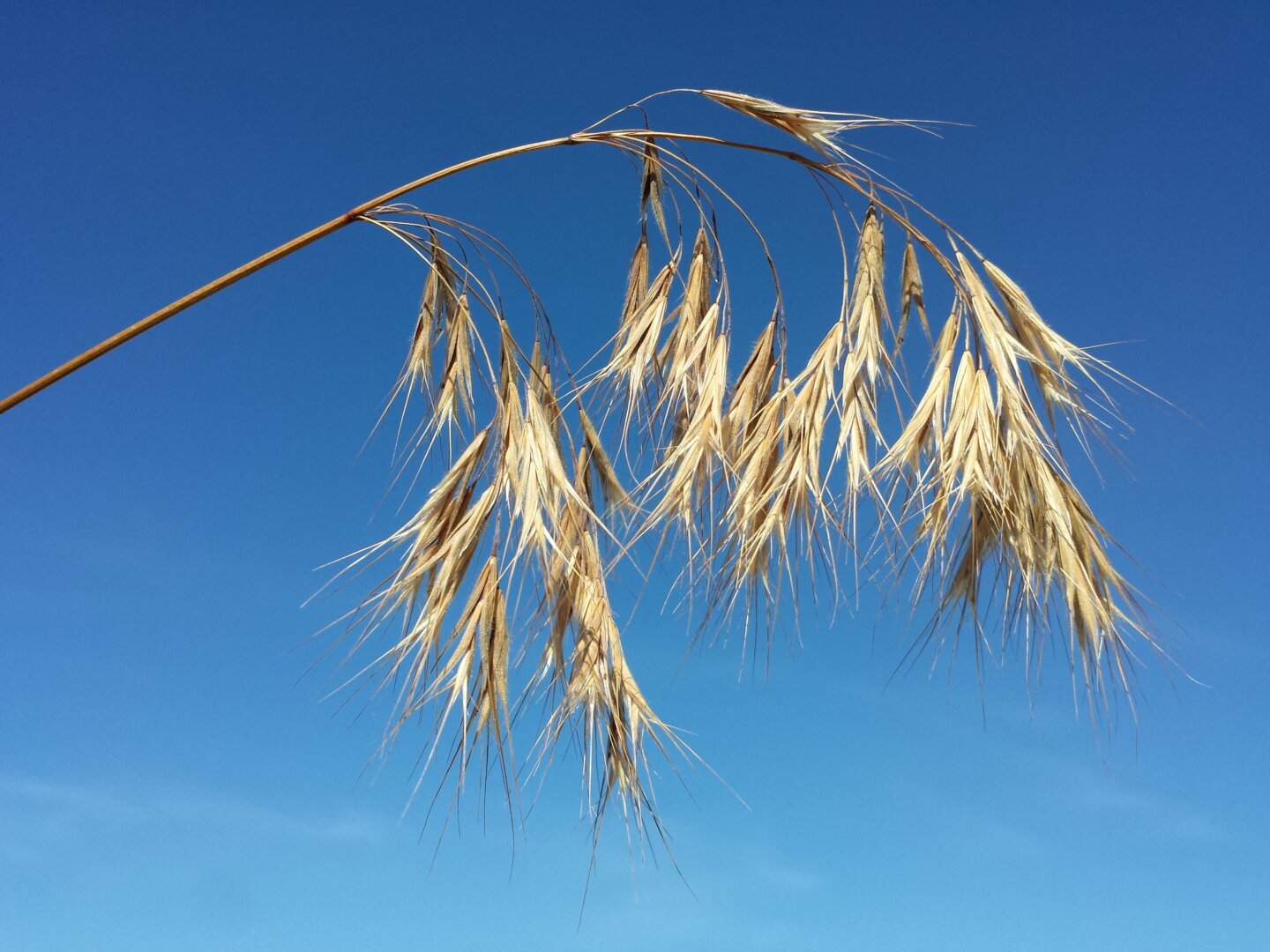Bromus tectorum
Description
- Cheatgrass is an annual grass that forms dense stands, growing 4″-24″ tall. It matures quickly, turning red-purple and then tan-buff when dried. The plant creates dense, flammable masses of dead grass, increasing wildfire risk. Its sharp awns are also dangerous if inhaled by animals, potentially causing severe respiratory issues.
- Stems: single-stalked, densely hairy with fine, soft hairs, and turn a dull red-purple color as they mature.
- Leaves: Sheaths are Soft-hairy, Blades are 2-4 mm wide, flat, hairy, with jagged ligules (1.2-3 mm long).
- Flowers: Compact panicle, erect then drooping, 6-15 cm long. Spikelets have 3-6 flowers, slender and smooth, up to 2 cm long.
- Seeds: Awned, narrowly sharp-pointed, 10-17 mm long; easily attach to animals or humans for dispersal.
Introduction and spread
- Origin: Native to Europe, specifically thriving in decaying straw of thatched roofs.
- Introduction to North America: Introduced in the late 1800s via packing materials, ship ballast, and contaminated crop seeds; first found near Denver, Colorado.
- Rapid Spread: Explosive spread in the late 1800s and early 1900s due to trampling by overstocked livestock and disturbances from homesteading and winter wheat cultivation.
Reproduction Method - Seed-Based Reproduction: Produces numerous seeds that germinate in favorable conditions.
- Efficient Dispersal: Seeds spread through wind, animals, and humans.
- Winter Annual: Germinates in fall, grows under snow, or sprouts early spring.
- Rapid Growth: Flowers early, sets seed, and dies by mid-summer.
- Prolific Seeding: Seeds disperse via wind, animals, and human activity.
- Dormancy: Seeds can remain viable in soil for several years.
Consequences of invasion
- Agricultural Impact: Reduces winter wheat yields and harms other crops.
- Livestock and Pet Hazards: If inhaled or consumed, the sharp seeds can cause abscesses in dogs, wildlife and livestock.
- Ecosystem Dominance: Outcompetes native plants, especially after disturbance.
- Fire Hazard: Highly combustible; increases wildfire frequency and intensity.
- Wildlife Decline: Reduces native plant cover, harming dependent wildlife.
- Economic Threat: Significant risks to cattle ranching and wheat farming.
- Control Priority: High-priority invasive species management target.
Status in the CKISS region
- Cheatgrass is currently classified as Insufficient Information on the CKISS Annual Priority List..
- There is insufficient information for these species on their distribution impacts, potential for spread and/or feasibility of control. Not enough information is available to assign a management category.
- To learn more about how CKISS classifies and manages invasive species, see our Invasive Species Priority Lists page
Integrated pest management options
Prevention
- Become PlantWise and learn about Grow Me Instead. Select alternative, non-invasive plants.
- Check your Hay for invasives
- Maintain healthy vegetation to outcompete cheatgrass.
- Patrol regularly and remove cheatgrass before seed set.
- Re-vegetate disturbed soils immediately with dense, early-colonizing plants.
- Work with neighbors to prevent the spread of cheatgrass.
- Avoid disturbing soil and clean equipment, clothing, and pets after exposure to infested areas.
Mechanical control
- Manual Techniques: Hand-pull small infestations before seed-set, ensuring all plants are bagged and disposed of properly.
- Mowing & Grazing: Mow every 3 weeks in spring and summer, and graze livestock before seed-set. Avoid overgrazing.
- Cultivation: Tilling may help but can also lead to regrowth. Avoid plowing as it promotes seed germination.
- Disposal: Bag and remove pulled cheatgrass plants to prevent reseeding. Do not compost the material.
Chemical control
- Use non-selective herbicides like glyphosate, following label instructions carefully.
- Herbicides like fluazifop, Metribuzin, and imidazolinone can prevent seed formation and reduce infestations.
- Chemical treatment is best combined with other methods like seeding or cultivation.
- For more details on chemical selection and application in BC, consult AgriService BC at 1-888-221-7141 or AgriServiceBC@gov.bc.ca.
Cultural control
- Avoid soil disturbance to prevent invasion.
- Controlled grazing and crop rotation can reduce cheatgrass dominance.
- Use dense plantings of competitive crops like sorghum to outcompete cheatgrass over time.
Biological control
- No effective biological control agents are currently available, though some soil bacteria show potential in research settings.








